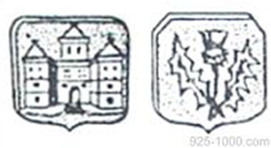| This Week’s Topic… | |

Best viewed in
|
Silver Hallmarks Identifying and authenticating antique and period jewelry is based on experience and knowledge. Hallmarking was legally established in England in 1300 under the reign of King Edward I. He ordered that all gold and silver items must undergo a test called an “assay” that would certify its fineness. His decree stated that all silver crafts must be made from .925 silver or “sterling silver” at least. These tests were conducted by governing bodies of craftsmen and silversmiths called guilds. During the reign of King Edward III, he granted a charter to the Worshipful Company of Goldsmiths (aka Goldsmith Company). This guild of goldsmiths had a guild hall in London called Goldsmith’s Hall where they engraved the markings on the assayed items. From this process, where the guilds stamped the mark of quality within their guild hall, the term hallmark was coined. The most accurate definition of a hallmark is the mark or marks stamped, impressed, or struck on gold, silver, or platinum which indicate fineness or karat (also called quality or purity marks). Depending on country of origin, hallmarks can also include symbols for place of assay, date of assay (in the form of a letter or a letter and a number), maker’s mark, importation or exportation mark if applicable, and tax or duty mark.
This set of marks indicates the piece was made of sterling, in the city of London, in 1789, during the reign of King George III, by Thomas Wallis. The British system of hallmarking is somewhat complex, but relatively easy to follow once the system is deciphered. British hallmarks include a fineness or purity mark, an assay office mark, a date letter, and usually but not always, a maker’s mark. A royal duty mark was added from 1784 to 1890 (not always found on jewelry of this period). The sequence of marks on a piece is arbitrary. Silver Standard Marks The Standard mark indicates the purity of silver.
A = Sterling
.925 City Mark For the sake of space, let’s look just at Edinburgh.
Edinburgh,
Scotland (1681 – 1974) Date Mark
The date letter system was introduced in London in 1478. It indicates the date the piece was presented for assaying or testing for silver content. Here is an example of Edinburgh’s date marks for 1861-1931. |



